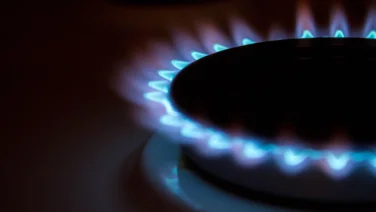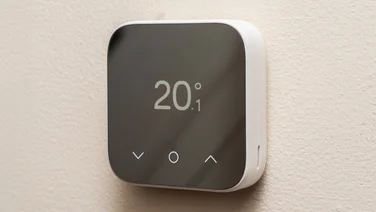To help us provide you with free impartial advice, we may earn a commission if you buy through links on our site. Learn more
- How to switch energy supplier: What to know before you begin
- Do I need to settle my bill before I switch?
- Can I still switch if I rent my home?
- My supplier has gone bust – should I switch?
- How to switch energy supplier: Step by step
- 1. Work out what you’re paying today
- 2. Research equivalent deals
- 3. Contact your new supplier
- You can still back out… if you’re quick
- 4. What if something goes wrong?

Learning how to switch energy supplier is more important than ever. Energy prices have been rocketing in recent years, and unless you’re on a fixed tariff whereby you’re paying a set price until a specified date, you’ll have been feeling the pinch. This is because the price you pay for gas and electricity is regulated by what’s known as an energy price cap. This is a limit on the amount that suppliers can charge for the energy used by an average British home in one year. It’s set by the regulator, Ofgem – and, in response to the increased costs energy firms are facing, it has risen to record levels.
The cap is now revised quarterly to reflect seasonal changes and global events. 2022 saw unusually large increases in the wholesale price of gas, which peaked at eight times its usual rate, and the price cap reached £3,549 in October 2022 before dropping to £3,280 in April. The government’s Energy Price Guarantee has softened the blow, effectively capping a typical household energy bill at around £2,500 per year until June 2023. Thankfully, though, there is some good news: from 1 July, the energy price cap will drop to £2,074.
Energy prices are set to remain high for the foreseeable future, with analysts predicting that prices will remain elevated until the end of the decade. One glimmer of optimism, however, is that the reduced price cap may see some energy suppliers start to tout fixed deals to lure new customers.
As such, if you’re not tied into an existing contract, it makes sense to survey the market as soon as you can to find the best deal, and switch if it means you’ll pay less.
READ NEXT: The best energy suppliers
How to switch energy supplier: What to know before you begin
Do I need to settle my bill before I switch?
If you owe your current supplier money, and you’re not on a prepayment meter, then according to Citizens Advice, you still have the right to switch if you haven’t yet received a bill or haven’t owed the money for more than 28 days. Any outstanding amount should be added to your final bill when the switch completes.
Those on prepayment meters can also switch, so long as they don’t owe more than £500 for either gas or electricity. Make sure you explain the situation to your new supplier, so they can transfer the debt onto their books using the Debt Assignment Protocol.
Can I still switch if I rent my home?
Do you pay your own energy bills? If so, the answer is almost certainly yes. As Ofgem explains, “consumer protection law says you must be able to choose your energy supplier if it is your responsibility to pay energy bills”. However, you may be required to revert the account to the original supplier at the end of your tenancy.
In those instances that a landlord pays the bills on your behalf, talk to them about taking over responsibility yourself, or ask them to switch to a better deal if you have identified one.
If the property was originally fitted with a prepayment meter, says Citizens Advice, “your landlord can’t stop you replacing a prepayment meter with a normal meter that lets you pay after using energy rather than in advance. You don’t need your landlord’s permission to do this.” Again, though, you may be required to have the prepayment meter reinstated at the end of your tenancy, and this may incur a charge.
If you live in a leasehold property, even if you own it, and are responsible for a portion of any communal bills – such as the cost of lighting shared areas – then talk to the management company if you believe you’ve found a better deal. Bear in mind, though, that if they’re covering the cost of this supply themselves and passing it on as part of your service charge, they may be paying a business tariff. This may not be directly comparable to any domestic rates you’ve researched on their behalf.
My supplier has gone bust – should I switch?
Even with Ofgem raising the cap every three months from October, suppliers can only take advantage of the increased headroom this gives them by hiking bills for customers on variable price contracts. Anyone on a fixed-price deal should see no difference. That’s good news for consumers, but not so good for suppliers.
If a large proportion of a supplier’s customers are on fixed tariffs, they’ll have no way to sufficiently offset their increased costs. This explains the reason that so many are going bust. If your supplier is among them, and your account is in credit, you’d be best advised to stick where you are for now; it can be more difficult to get your credit repaid once you’ve switched.
However, the good news is that your current supplier going bust doesn’t mean you’ll be cut off. Ofgem is working with remaining providers to move customers onto their books, and your supply should remain uninterrupted throughout.
READ NEXT: Expert Reviews Energy Awards
How to switch energy supplier: Step by step
In most cases, switching suppliers is easy and relatively quick, requiring a few hours’ research on your part, and a wait of around three weeks.
1. Work out what you’re paying today
Unless you know what you’re already paying – and how much energy you’re using – you have no way of comparing rival deals.
You’ll find details of your current tariff on your latest bill, which will also include a figure for estimated annual use, unit rate and daily standing charge. Note that if you have different suppliers for gas and electricity, you’ll need to take the account of the separate figures for both when searching for deals, including dual fuel options.
If you can’t find a recent bill, call your current supplier – or suppliers – to ask for the relevant details. If you don’t know who your suppliers are, you can find out online:
- The Meter Point Administration Service can tell you who your gas supplier is. Either call it on 0870 608 1524, or use its online search tool by entering your postcode at www.findmysupplier.energy.
- The Energy Network Association’s search tool at www.energynetworks.org can tell you who your electricity network operator is on entering your postcode. Note that your network operator isn’t your energy supplier. However, the result of your search will include the operator’s general inquiries contact number (and a number to report power cuts, which is irrelevant here). Call the general enquiries number and ask who supplies your power.
2. Research equivalent deals
There are more price comparison sites than you might imagine, with big names such as Uswitch and MoneySuperMarket lining up alongside less familiar players. Look for the Ofgem Confidence Code hallmark for domestic price comparison services. Any service displaying this mark must comply with given standards for independence, transparency, accuracy and reliability. The Code is revised from time to time, with the latest revision published in 2017.
When looking for the best deal it can help to know the name of your existing tariff, since many comparison services can use the price points on which it’s based to more accurately gauge the savings you’ll make by switching to a rival supplier.
If you’re currently on either an Economy 7 or Economy 10 tariff, White Meter in Scotland, or TwinHeat, and use a switching meter, make sure your new provider can serve the hardware already in your home, since it isn’t always possible to sign up for a single-rate tariff using dual-rate hardware. Likewise, if you’re on a prepayment meter, make sure your new supplier can accommodate this setup.
If you have a smart meter and want to continue using it to automatically submit readings to your new supplier so you don’t have to read the meter yourself, check that it’s compatible with the new provider’s network. If not, ask whether they’ll issue a replacement free of charge.
Don’t only look at the headline rates for electricity and gas when comparing possible deals. Take into account the standing charge, too, where a few pennies’ difference per day can add up to a significant amount over the full term of the contract.
If you can afford it, we’d also recommend researching eco-friendly options where available. Although you’ll receive the same gas and electricity as everyone else, which will be generated using a mix of fossil fuels (around 60% of our power is generated this way), nuclear and renewable energy, what you pay will support generation from renewable sources.
Finally, check out online customer reviews and Citizens Advice’s supplier scores (most recently for October to December 2022), which take into account the number of complaints, bill clarity, customer guarantees, how easy it is to contact a supplier and how easy it is to switch, to generate an overall rating.
Ofgem publishes its own supplier scorecard, which includes metrics for the number of complaints made about suppliers per 100,000 customers. However, the most recently updated edition linked from its site is dated January 2021.
3. Contact your new supplier
Should you find a better deal than you’re already on, switching is relatively painless. However, before going any further, it’s worth calling your current supplier to see if they can match the new rate. Bear in mind that some of the prices you’ll be offered will be new customer rates that revert to more expensive tariffs once the introductory period has elapsed. Your existing supplier may be less keen on matching these than they would a regular, ongoing deal.
If you plan to proceed with the switch, either sign up with the new supplier online or by phone. They will handle the switch on your behalf, and will contact your existing supplier to inform them that you’re leaving. The process should complete in around three weeks, and neither your gas nor electricity supply should be interrupted.
Those attempting to switch before an existing contract has expired may be liable to pay an exit fee, and this could even apply if you’re switching to a different deal but sticking with the same supplier. However, as Energy Helpline explains, “Ofgem has ruled that your energy supplier can’t charge you any exit fees if you switch within the last 49 days (or 7 weeks) of your contract”.
Fortunately, these fees tend to be relatively light – often less than £50 – and it’s possible that the savings you make by switching to a more attractive contract will see you recoup the charge. Nonetheless, check the amount you’ll be charged in advance of contacting the new supplier and, if you still wish to proceed, ask the new supplier whether they will cover the cost. Although rare, this isn’t unheard of.
Once the switch is complete, your old supplier should send you a final bill within six weeks. If your account was in credit, then your old supplier will issue a refund. Energy UK sets suppliers a target of issuing 90% of refunds within 10 working days.
You can still back out… if you’re quick
We’d advise proceeding with caution when picking a new energy supplier, as you’ll be entering into a contract when you switch. However, should you discover soon after agreeing to the switch that you’ve changed your mind, you can cancel within 14 days.
Contact your new supplier to discuss your options within two weeks of signing up, and prior to the switch completing, if you find yourself in this situation.
4. What if something goes wrong?
Switching is a relatively pain-free process, but problems can still occur. These can be a result of inconsistencies in the national network records and, in particular, the assignment of meters to properties.
Suppliers use street addresses when sending out bills, but Meter Point Reference Numbers (MPRNs) for gas and Meter Point Administration Numbers (MPANs) for electricity when identifying the meters they’re supplying. It’s important that these numbers are accurately assigned to the properties in which they’re located. If not, the supplier may end up taking over your neighbour’s supply by referencing the street address rather than the MPRN or MPAN.
You’ll find your MPRN on your gas meter and your MPAN on your electricity meter, and it’s worth giving these to your new suppliers when discussing your switch, so they can check that the records are accurate. If not, they can be updated by the relevant network operators upon receiving a request from your energy supplier.
The situation can be further complicated if a neighbouring street address has been associated with your MPRN or MPAN. In this instance, your neighbour will need to ask their supplier to correct the record for their own meter first, before you can do the same with your own supplier. Each correction can take up to 40 days to process.
No matter the problems you encounter, your first port of call should be your new supplier, as they will have managed the switch on your behalf. If you don’t get any satisfaction, don’t immediately put in a complaint with the regulator: you must give your supplier a minimum of eight weeks to put things right, or tell you how they plan to remedy the situation. If they don’t do this, or you’re unhappy with their response, you can at that point – and within 12 months – refer the matter to the Energy Ombudsman.






